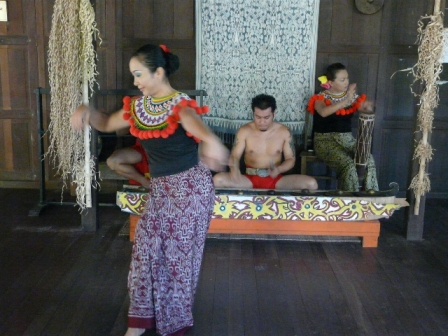|
Dec 8 2008
We were in no rush to leave Kuching. There are several
National Parks nearby to explore and we were getting comfortable with
this mixture of modern and small-shop Asian life. The modern is several
multi-story fancy hotels, including a Holiday Inn and Hilton, right near
us and a refurbished promenade along the river. We aren't sure what the
occupancy rate of the large hotels here as Kuching doesn't seem to be a
world-class destination - yet - although I am sure they would love to
be.
The usual Asian style is evident in the small shops lining
every street. The stores are set back from the upper stories of the
buildings, providing a shady overhang for the shop and pedestrians. The
problem is that each small shop tries to make the sidewalk in front of
their shop unique. The owner not only tiles the sidewalk in a pattern
that suits the business, they make sure the level of the sidewalk is a
few inches higher or lower than the adjacent shop. This creates problems
for the pedestrian. If you don't walk carefully you are liable to miss
your step and land on your face. Maybe this ensures the pedestrian walks
more slowly past each store instead of rushing past. Plus, who rushes in
a hot Asian country anyway. We learned to take our time, walk in the
shade and avoid sunstroke.
Kuching
is actually Malaysian for cat, so there are kitschy painted concrete
monuments to cats demarcing the business area. No one is sure of the
correct origin of the name but various theories say that the city was
renamed from Sarawak to Kuching after wild cats that used to roam the
area, or the local dignitary, when asked the name pointed out a cat
passing by, then again it could have been a corruption of "cochin", an
asian name for "port". Anyway, cats are the symbol of the city.
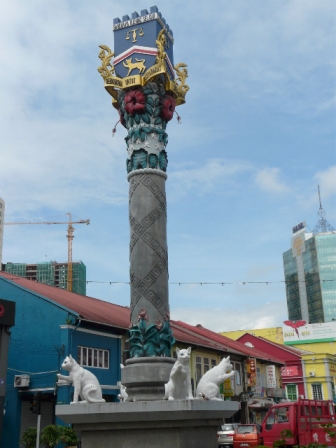
Kuching Cat Tower |
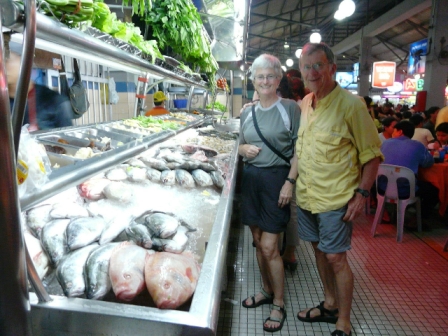
Seafood Restaurant |
Another unique feature of Kuching is the seafood food center located on
the top floor of a six-storey parking garage. We loved the food hawker
centers in Singapore and were pleased to find they are a feature of
Kuching as well, but the location of Top Spot was unusual. We had dinner
there one night and returned the next night as well. Large stalls line
two sides of the open air rooftop location. Each stall has a
multi-tiered display of their wares. Live or freshly caught fish and
seafood of every description on the bottom tier and fresh vegetables on
the next two tiers.
You
line up in front of the display, choose the seafood and vegetables you
want, priced by weight, choose how the dishes are to be cooked, add rice
to accompany your meal and wait for it to be cooked. You sit at big
round tables set in front of each stall and order your drink from roving
servers. We were advised not to order too much because if you are still
hungry you can order an additional dish and it will quickly appear.
Delicious.
We have been visiting the many local sites and
museums. The Sarawak Museum has interesting exhibits of each of the
tribes who live in this area and the longhouses that were once the
communal home of the people. It reminded me of the West Coast Indians.
The Borneo people even had their version of a totem pole outside the
longhouse. Most of the traditional culture has disappeared, much the
same as the native North American culture.
Kuching is the craft
sale center for Borneo. There are numerous shops right near our hotel
selling both genuine stuff and cheap souvenir imitations. One quality
shop is co-owned by a local artist Ramsey Ong and the owners of
Singgahsana Lodge, our hotel. Ramsey paints and does collages using
traditional materials such as bark cloth and the owners are talented
photographers. There are many art works decorating the walls of the
lodge. The shop also showcases other local artists and beautiful
textiles, some just display peices, some fashioned into clothing. I
would love to bring a few pieces home but the price and the thought of
lugging anything more around for the rest of our trip have stopped any
purchases. Instead I visited the new, excellent Textile Museum and
admired the talent of the women who wove and decorated everything they
used and wore.
One morning we had a treat. We visited the
Semenggoh Wildlife Rehabilitation Center, about 30 km SW of Kuching. The
draw for increasing numbers of tourists are the semi-wild orang-utans.
There are 24 orang-utans and two as yet unnamed babies is residence. The
center is in the middle of a government owned jungle forest area. The
area looked in need of protection as housing developments are being
built right up to the edge of the center.
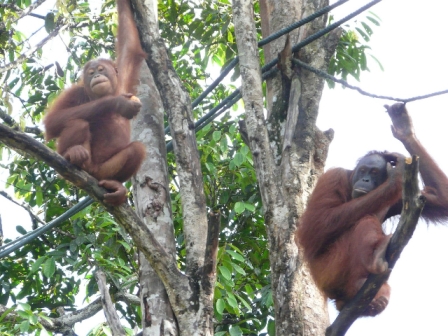 Tourists
come to see which animals will turn up at the twice daily feeding
stations. The conservation staff fill bowls of fruit on platforms at two
areas beneath the trees. There is no guarantee that any urang-utans will
turn up but we were lucky. Three family groups, the two mothers of the
new babies with their young clinging to their shaggy orange fur, both
with an older sibling tagging along, plus a third mother with a two year
old. At the stations, the urang-utans descend on ropes and vines to grab
what catches their eye and climb back up the ropes to eat and show off.
The other orang-utans are able to forage in the surrounding forest for
themselves. Tourists
come to see which animals will turn up at the twice daily feeding
stations. The conservation staff fill bowls of fruit on platforms at two
areas beneath the trees. There is no guarantee that any urang-utans will
turn up but we were lucky. Three family groups, the two mothers of the
new babies with their young clinging to their shaggy orange fur, both
with an older sibling tagging along, plus a third mother with a two year
old. At the stations, the urang-utans descend on ropes and vines to grab
what catches their eye and climb back up the ropes to eat and show off.
The other orang-utans are able to forage in the surrounding forest for
themselves.
One of the mothers with her infant clinging to her
decided to come down to ground level in front of one of the conservation
buildings. We had been warned to keep a 5 M distance between us and the
animals but several people, including me, walked over to the area where
the mother was, still keeping our distance. Orang-utans are reputed to
be 7 times stronger than humans and a mother with a baby is not to be
trifled with. All of a sudden the mother started coming directly towards
me and I was on a roped walkway trapped against the building. The guide
who brought Ray and me called to one of the conservation workers to come
to my rescue. I just remained quiet and he put himself between me and
Mom while she quietly passed us along the walkway and swung down onto
the forest floor below and was gone. You are not supposed to touch the
animals but I could have.
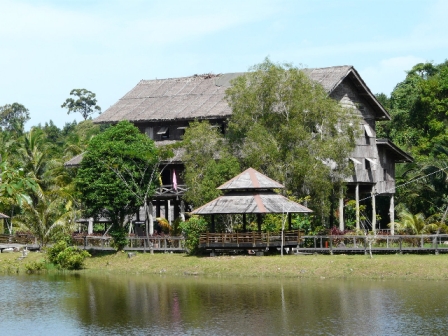 One
of the must see tourist spots outside Kuching is the Sarawak Cultural
Village. Hundreds of visitors come each day but the 27 sq-km park can
easily manage the crowds and does so with taste. The village is
beautifully situated around a small artificial lake with jungle covered
hills in the background. The compound includes six homes typical of the
many cultures found in Sarawak state. There are the longhouses of four
different indigenous tribes, a Malay town home and a Chinese farm house,
as well as a large theatre. The government has gone to great lengths to
ensure that everything is authentic and that the buildings are
constructed according to traditional methods. One
of the must see tourist spots outside Kuching is the Sarawak Cultural
Village. Hundreds of visitors come each day but the 27 sq-km park can
easily manage the crowds and does so with taste. The village is
beautifully situated around a small artificial lake with jungle covered
hills in the background. The compound includes six homes typical of the
many cultures found in Sarawak state. There are the longhouses of four
different indigenous tribes, a Malay town home and a Chinese farm house,
as well as a large theatre. The government has gone to great lengths to
ensure that everything is authentic and that the buildings are
constructed according to traditional methods.
Each
building is staffed by tribespeople who demonstrate crafts such as
basketry, weaving, instrument making and even blow-pipe shooting. For a
small fee, you can even dress up in a traditional costume to feel more
part of the community.
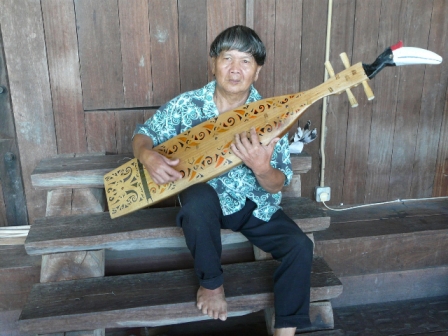
Traditional Stringed instrument |
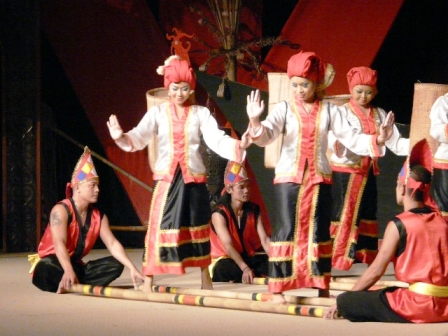
traditional dancers |
There
are twice daily performances of traditional music and dances in the
theatre, performed by the tribespeople. It has been a great success and
the mainly Malay crowd there when we attended enjoyed the show just as
much as we did.
The other must visit spot is Bako National Park. You take a 45 minute
bus ride then a 30 minute boat ride to reach this National Park at the
mouth of the Sarawak and Bako Rivers leading to the South China Sea.
The
park is the home of the rare Proboscis monkey, several very nervy
macaque monkeys, plus several other animals and reptiles. The macaques
were right beside the boat jetty, waiting for some unsuspecting tourist
carrying a bag of snacks or a soft drink. Before the tourist would know
it, that snack or drink would be the next meal of a macaque. Our boat
driver helped us get past the cute, cunning little beasts by yelling and
threatening them with his flip flop. It worked.
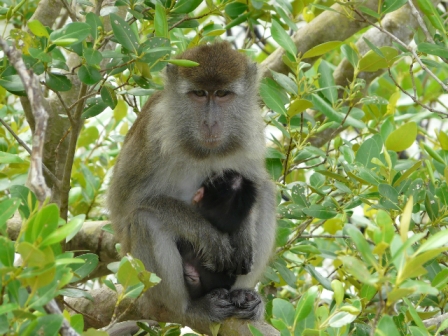
macaques mother and baby |
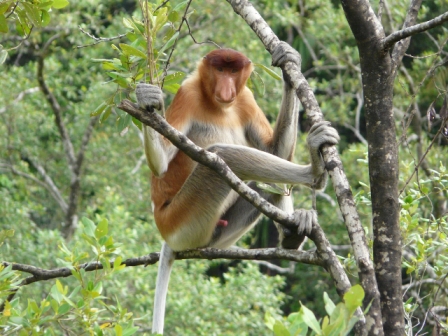
Proboscis |
Just
past the macaques was a group of those weird-looking Proboscis monkeys;
that's him with the long dangling nose. They are much more docile and
entertained us by watching us and jumping from tree to tree.
Bako
has lots of hiking trails through the jungles. We did the Lintang 5.8 km
circle walk that brought us up a limestone escarpment to enjoy views of
the surrounding countryside. We got back to the park canteen just in
time to take shelter during the daily rain storm. We put our day pack
down on a table intending to choose our lunch from the canteen
restaurant. If it were not for a vigilant staff member Ray would have
lost his day pack to a macaque perched on a tree beside the canteen
veranda! A Dutch tourist told us his girlfriend lost a hot dog to a
monkey and then her can of pop! We moved to a safer table to eat our
meal.
We shared our last dinner at the top-of-the-car-park restaurant in
Kuching with some American tourists. We ate a delicious meal of red
snapper while listening to their rave reviews of their travels in Sabah
state, our destination in a week or two.
Return to
Borneo Into
Return to
Malaysia-Thailand Intro
Return to Travels
Return to Introduction |
